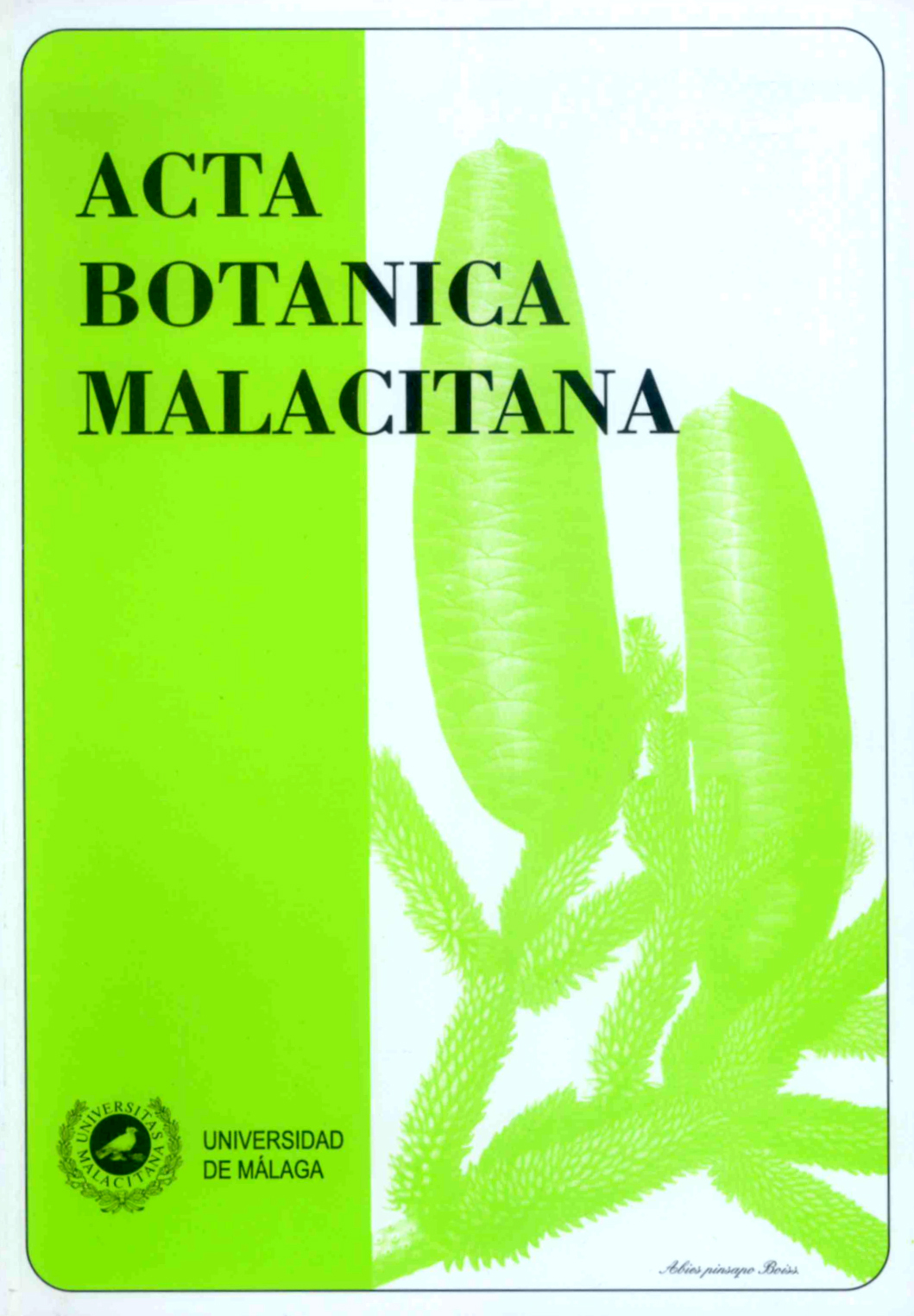Flowering phenology of Mediterranean Quercus species in different locations (Córdoba, SW Iberian Peninsula).
DOI:
https://doi.org/10.24310/abm.v32i0.7033Abstract
ABSTRACT. Flowering phenology of Mediterranean Quercus species in different locations (Córdoba, SW Iberian Peninsula). Periodical qualitative and quantitative checking of flowering phases was carried out over six growing seasons (1997-2002) for the three Mediterranean Quercus species found in Sierra Morena (Córdoba, SW Spain): Q. ilex L. ssp. ballota (Desf.) Samp., Q. coccifera L. and Q. suber L. A total of 60 individuals were selected. Additionally, 30 Quercus ilex ssp. ballota individuals were selected and studied in Sierras Subbéticas (Priego de Córdoba, SW Spain) in 1999 and 2000. Morphological changes occurring at different points in each phenological phase were charted. Among species differences were found for inflorescences/male and female flowers, in terms of the phenological flowering sequence. Male inflorescences displayed a more homogeneous development. All individuals and populations were proterandrous. Phenological trends and ranges were charted. Although trends varied with species and year, the overall phenological trend seemed to fit a sigmoid curve in all cases, increasing with phenological development. Shorter ranges were obtained in years with warmer springs, and longer ranges in colder years. Moreover, phenological range differed as a function of species and location. In general, Q. ilex ssp. ballota flowered earlier than the rest, Q. suber displaying the latest flowering period. Individuals located at lower altitudes and facing the sun flowered earlier, followed in most years by those located at higher altitudes. Thus, Q. ilex ssp. ballota flowered earlier in Sierra Morena than in the higher-altitude Sierras Subbéticas.
Key words. Flowering, Quercus, reproductive phenology, range, tendency.
RESUMEN. Fenología floral de tres especies mediterráneas de Quercus en diferentes localidades (Córdoba, Suroeste Península Ibérica). Se ha realizado un seguimiento periódico cuantitativo y cualitativo de las fenofases florales de tres especies mediterráneas de Quercus localizadas en Sierra Morena (Córdoba, suroeste de España) por un periodo total de seis años (1997-2002): Q. ilex L. ssp. ballota (Desf.) Samp., Q. coccifera L. y Q. suber L. Se seleccionaron un total de 60 individuos de las tres especies. Adicionalmente, un total de 30 individuos de Quercus ilex ssp. ballota fueron seleccionados y estudiados en las Sierras Subbéticas (Priego de Córdoba, suroeste de España) durante los años 1999 y 2000. Se estudiaron los cambios morfológicos ocurridos en cada fase fenológica. Se encontraron diferencias en el desarrollo fenológico entre inflorescencias/flores masculinas y femeninasen las diferentes especies estudiadas. Las inflorescencias masculinas mostraron un desarrollo más homogéneo. Todos los individuos y las poblaciones fueron proterandros. Las tendencias y amplitudes fenológicas fueron representadas gráficamente. Aunque las tendencias variaron en función de la especie y el año considerado, la tendencia general en todos los casos, se asemejó a una curva sigmoide aumentando su pendiente a medida que avanza su desarrollo fenológico. Las amplitudes fenológicas más cortas se obtuvieron los años con primaveras más cálidas, y las mayores en las más frías. Además, la amplitud fenológica fue diferente en función de la especie y la localización de los individuos. En general, Q. ilex ssp. ballota floreció antes que el resto, Q. suber presentó el periodo de floración más tardío. Los individuos localizados a menores altitudes y los dispuestos en dirección al sol florecieron antes, seguidos la mayoría de los años por aquéllos situados en altitudes mayores. De esta forma, Q. ilex ssp. ballota floreció antes en Sierra Morena que en las Sierras Subbéticas situadas a mayor altitud.
Palabras clave. Floración, Quercus, fenología reproductiva, amplitud, tendencia
Downloads
Metrics
Downloads
Published
How to Cite
Issue
Section
License
Those authors who publish in this journal accept the following terms:
a. The authors will retain their copyrights and guarantee the journal the right of first publication of their work, which will be simultaneously subject to the Creative Commons Attribution-Non-commercial 4.0 license whose full text can be found at <http: // creative commons .org / licenses / by-nc / 4.0> that allows third parties to share the work as long as its author and its first publication are indicated, and as long as it is not for commercial purposes.
b. Authors may adopt other non-exclusive licensing agreements for the distribution of the version of the published paper (e.g., deposit it in an institutional telematic file or publish it in a monographic volume) provided that the initial publication in this journal be indicated.
c. Authors are allowed and recommended to disseminate their work through the Internet (e.g., in institutional telematic archives or on their websites) before and during the submission process, which can produce interesting exchanges and increase citations of the published work. (See The effect of open access)







1.png)
